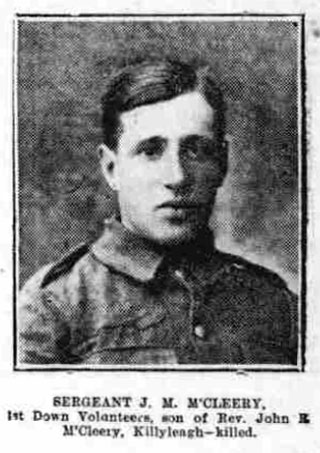Private Robert McCleery
Robert McCleery was born on 29 July 1893 at Killyleagh, Downpatrick, County Down, the seventh of nine children of Presbyterian clergyman John Richard McCleery and his wife Henrietta Frances (née Hodgens). Although he grew up in Killyleagh, by the time of the 1911 Census he and his brother William Victor were living as boarders at 1 Bedeque Street, Belfast, William working as a mill manager and Robert as an apprentice manager.
Robert enlisted in the North Irish Horse between 6 and 28 June 1916 (No.2198). He trained at the regiment's Antrim reserve depot before embarking for France in late 1916 or the first half of 1917, where he was posted to one of the squadrons of the 1st or 2nd North Irish Horse Regiments.
In August-September 1917 the 2nd NIH Regiment was disbanded and its men, together with some surplus to the needs of the 1st NIH Regiment, were transferred to the Royal Irish Fusiliers, an infantry regiment. McCleery was one of 70 men given the job of conducting the regiment's horses to Egypt, to be handed over for use by mounted units there. They embarked from Marseilles on board HMT Bohemian on 25 August. After a month at Alexandria they returned to France, via Italy. On 5 October 1917 they arrived at the 36th (Ulster) Division Infantry Base Depot at Harfleur for infantry training, and after just a few days were posted to the 9th (Service) Battalion, Royal Irish Fusiliers – which had been renamed the 9th (North Irish Horse) Battalion – joining it in the field at Ruyaulcourt on 12 October. McCleery was issued regimental number 41593 and posted to D Company.
He probably saw action with the battalion at the Battle of Cambrai in November and December 1917.
McCleery was one of the many posted as missing following the 9th (NIH) Battalion's fighting withdrawal from St Quentin from 21 to 28 March 1918 during the German spring offensive. It was later learned that he had been captured on 22 March near Seracourt. He remained a prisoner until the end of the war, held at a camp in Stendal.
Soon after the war McCleery emigrated to Canada, where he settled in Yukon and joined the Royal Canadian Mounted Police. On 3 March 1923 he married Susan Helen Tayor. He died in Whitehorse, Yukon, on 6 January 1954 and was buried in the Pioneer Cemetery.

At least two of McCleery's brothers also served in the war. John Richard McCleery served as a sapper in the Canadian Engineers. James Moore McCleery, a sergeant in the 13th Battalion, Royal Irish Rifles, was killed on the Somme on 1 July 1916, and is commemorated on the Thiepval Memorial.

Belfast Weekly Telegraph, 29 July 1916

Northern Whig, 20 July 1916
Gravestone image sourced from the Find-a-Grave website.
